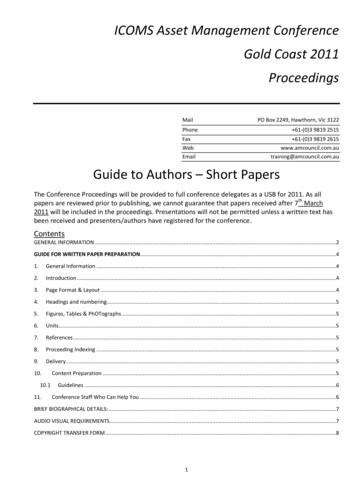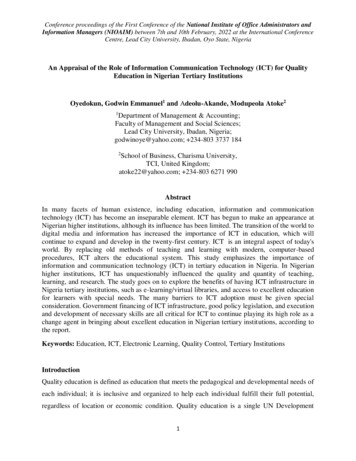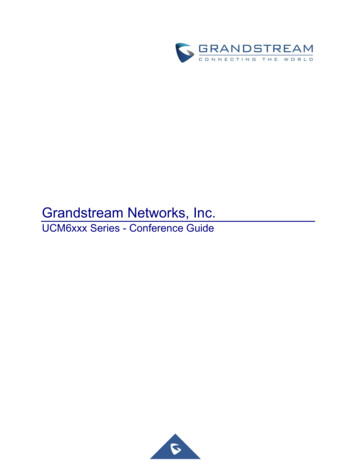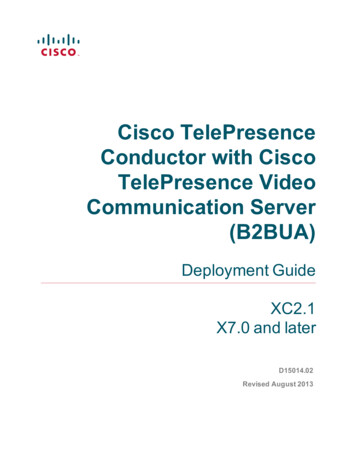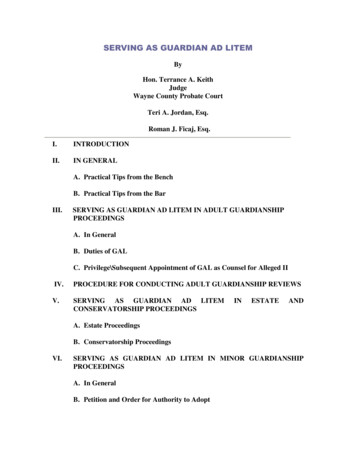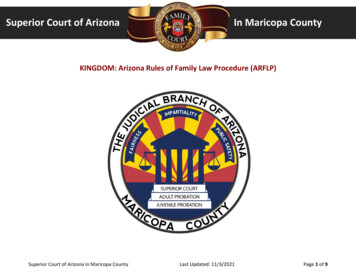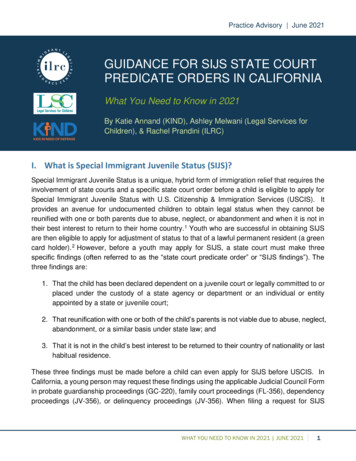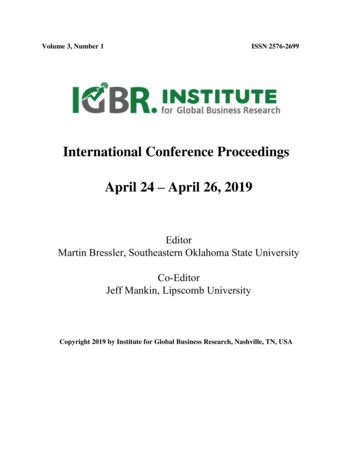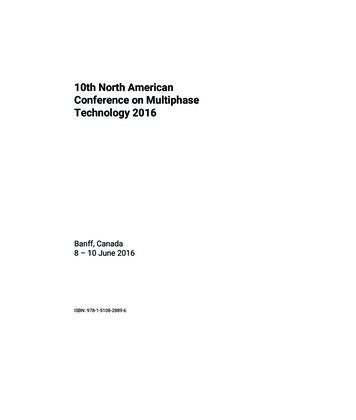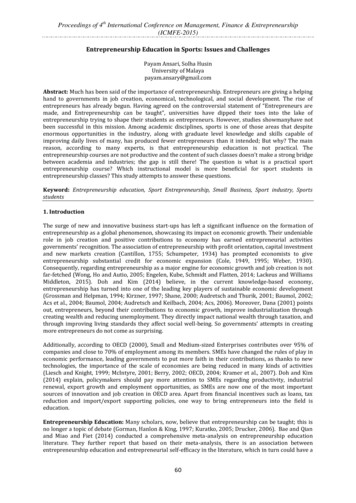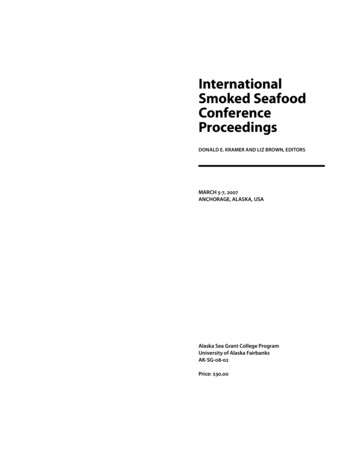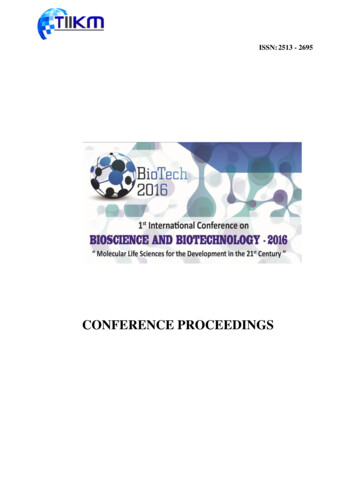
Transcription
ISSN: 2513 - 2695CONFERENCE PROCEEDINGS
CONFERENCE PROCEEDINGS12th – 13th January, 2016Colombo, Sri LankaCommittee of the BioTech- 2016The International Institute of Knowledge Management (TIIKM)Tel: 94(0) 11 3132827info@tiikm.comii
DisclaimerThe responsibility for opinions expressed, in articles, studies and other contributions in thispublication rests solely with their authors, and this publication does not constitute anendorsement by the BioTech or TIIKM of the opinions so expressed in them.Official website of the conferencewww.bioscienceconference.comConference Proceedings of the International Conference on Bioscience andBiotechnology, 2016Edited by Emeritus Prof. Eric H Karunanayake and Udayangani PremarathneISSN: 2513 - 2695Copyright @ TIIKMAll rights are reserved according to the code of intellectual property act of Sri Lanka,2003Published by The International Institute of Knowledge Management (TIIKM)Tel: 94(0) 11 3132827Fax: 94(0) 11 2835571iii
Hosted by:Faculty of Applied Sciences, University of Sri Jayewardenepura, Sri LankaOrganized by:The International Institute of Knowledge Management (TIIKM)BioTech 2016 CommitteeEMERITUS PROF. ERIC H KARUNANAYAKE(Chair, BioTech 2016)Emeritus Professor of Biochemistry, Institute ofBiochemistry,MolecularBiologyandBiotechnology, University of Colombo, SriLanka.PROF. ATTA-UR-RAHMAN, FRS(Key-Note Speaker/ Session Chair, BioTech2016)UNESCO Science Laureate/ Professor Emeritus,International Centre for Chemical & BiologicalSciences, University of Karachi, Pakistan.PROF. K.M. NALIN DE SILVA(Key-Note Speaker/ Session Chair, BioTech2016)Professor of Chemistry, University of Colomboand Science Team Leader, Sri Lanka Institute ofNanotechnology (SLINTEC), Sri Lanka.PROF. WEI ZHANG(Key-Note Speaker/ Session Chair, BioTech2016)Director of Flinders Centre for MarineBioproducts Development and Head ofMolecular Bioprocess Engineering Laboratory,President of Australia, New Zealand MarineBiotechnology Society.PROF. KAMANI TENNEKOON(Session Chair, BioTech 2016)Institute of Biochemistry, Molecular Biology andBiotechnology, University of Colombo, SriLanka.iv
DR. DINITHI PEIRIS(Session Chair, BioTech 2016)Department of Zoology, Faculty of AppliedSciences, University of Sri Jayewardenepura, SriLanka.DR. ASHISH WADHWANI(Session Chair, BioTech 2016)Department of Pharmaceutical Biotechnology,JSS College of Pharmacy, India.DR. DILANTHA GUNAWARDANA(Session Chair, BioTech 2016)Department of Botany, Faculty of AppliedSciences, University of Sri Jayewardenepura, SriLanka.MR. ISANKA. P. GAMAGE(Conference Convener, BioTech 2016)The International Institute of KnowledgeManagementMR. OSHADEE WITHANAWASAM(Conference Publication Chair, BioTech 2016)The International Institute of KnowledgeManagementMS. SUVINIE RAJAPAKSHA(Conference Coordinator, BioTech 2016)The International Institute of KnowledgeManagementEditorial Board-ICOMBoard - BioTech- 2016Editorial2013Editor in ChiefEmeritus Prof. Eric H Karunanayake, Emeritus Professor of Biochemistry, Institute of Biochemistry, MolecularBiology and Biotechnology, University of Colombo, Sri LankaEditorial BoardMr. D. T. Rathnayake, Faculty of Management Studies and Commerce, University of Sri Jayewardenepura, SriLankaMs. Udayangani Premarathne, The International Institute of Knowledge ManagementThe Editorial Board is not responsible for the content of any research paper.v
ScientificCommittee- BioTech - Of2016Prof.OyaziwoAluede, DepartmentEducational Foundations And Management, Ambrose AlliProf.Kamani Tennekoon, University Colombo, Sri Lanka.Dr.Sumadee De Silva, University Colombo, Sri Lanka.Dr.Nimal Punyasiri, University Colombo, Sri Lanka.Dr.Sameera R Samarakoon, University Colombo, Sri Lanka.Dr. Ashish Wadhwani, JSS College of Pharmacy, IndiaDr. Shamim Ahmed, Shahjalal University of Science and Technology (SUST), Bangledesh.Dr Narayan Saha, Shahjalal University of Science and Technology (SUST), Bangledesh.Dr. Anugya Bhatt, Sree Chitra Tirunal Institute for Medical Sciences and Technology, India.Dr A.Sabareeswaran, Sree Chitra Tirunal Institute for Medical Sciences and Technology, India.Dr. Md. Mohiuddin Kabir, East West University, Bangladesh.Dr. A Maya Nandkumar, Sree Chitra Tirunal Institute for Medical Sciences & Technology, IndiaAssoc. Prof. Bishwajit Kundu, School of Biological Sciences, IIT Delhi, Indiavi
MESSAGE FROM PROF. ATTA-UR-RAHMAN, FRSKEYNOTE SPEAKER - BioTech 2016Biotechnology has emerged in recent years as a powerful medium for socio-economic development.A large number of biotechnologies are being developed which include recombinant vaccines, vaccinesin drug delivery, molecular diagnostics, bioremediation, sequencing of genomes, bioinformaticsdevelopment, genetically modified crops, recombinant therapeutic proteins etc. Multibillion dollarindustries are being developed in many of these fields and countries such as Cuba, which are investingmassively in such technologies, have begun to benefit in a major way.The three major players in the development of a knowledge economy are universities, industry andthe government. All three thrive on the extent of merit-based competiveness that should be in-builtinto the systems and on the efficiency of interaction among all three players. The development of aknowledge economy requires a thorough understanding of the dynamic interplay between research,invention, innovation, and economic growth. Such an understanding allows them to be modulatedaccording to national needs and challenges.The global trends in manufacturing and exports over the last 3 decades clearly show a sharp rise inhigh and medium technology goods and a sharp consistent decline in low technology goods and innatural resources. The big money lies in high technology and countries that have realized this haveinvested massively in knowledge-based economies leading to the manufacture and exports ofelectronics, pharmaceuticals, engineering goods, biotech products, computers, software, automobiles,aircraft, defense equipment, alternative energy products and many other such items requiring highlyspecialized skills and world class research centres. That is why the annual exports of a tiny countrywhich has a population only of about 5 million and no significant natural resources, Singapore, are astupendous US 458 billion.Pakistan made remarkable progress in science and higher education during the 9 years (2000-2008)when I was Federal Minister for Science & Technology as well as the Federal Minister responsible forHigher Education that resulted in over 1000% increase in international publications in high impactjournals and even greater increases in citations and PhD output. This laid the foundations of a strongknowledge economy.I hope such issues as well as the exciting recent advances in biotechnology will be discussed in depthat the conference.I wish Biotech-2016 all success.Prof. Atta-Ur-Rahman. FRSUNESCO Science Laureate/ Professor Emeritus, International Centre for Chemical &Biological Sciences, University of Karachi, Pakistan.vii
MESSAGE FROM PROF. SAMPATH AMARATUNGEIt is with great pleasure I warmly welcome all participants to the First Annual InternationalConference on Bioscience and Biotechnology 2016 on behalf of University of SriJayewardenepura, the hosting partner of the Conference which is organized by TheInternational Institute of Knowledge Management (TIIKM) during 12-13 January atColombo, Sri Lanka under the theme of “Molecular Life Sciences for the Development in the21st Century”.Bioscience and Biotechnology, in both developed and developing countries are increasinglyimportant fields in the modern era. The innovations and researches in this field are alreadyimpacting the society positively and hence we could expect more innovations that willcontribute to the sustainability of human beings in this century. Main conference tracksbeing Bioprocess and Biological Engineering, Agriculture and Food Biotechnology,Bionanotechnology, Biopharmaceutics and Medical Biotechnology, and Biodiversity andNatural products. I have no doubt that this conference can promote such developments andinnovations in the field of Bioscience and Biotechnology in this country and at the globallevel.I wish the Conference every success and wish to see the knowledge and expertise derivedfrom the 1st Conference will go a long way enriching the fields of Bioscience andBiotechnology and thereby contribute to the developmental activities both local and abroad.Prof. Sampath AmaratungeVice Chancellor,University of Sri Jayewardenepura,Sri Lankaviii
Table of ContentsPage No01. Potency of Agricultural Waste for Forage in Tobasa Regency01Manurung Adelina02. Analysis of Blood Transcriptome in Patients with Chronic KidneyDisease of Uncertain Aetiology05Mr. S. Sayanthooran03. In Vitro Micropropagation of Gyrinops walla (Gaerth.) Using LeafDisc Explants11Mr. A.N. Buddhapriya04. In-Vitro Multiplication of Ginger (Zingiber officinale Rosc.)15Cultivars -Local, Chinese and RangunMs. D.B.R Swarnathilaka05. Establishment of a Molecular Based Method for the Identification21of Skipjack Tuna (Katsuwonus pelamis) in Large Scale FishProcessing IndustryMr. D.R.C Perera06. Screening of Spring Wheat Varieties Resistant to Soil Pollutionwith Heavy Metals to Create Ecologically Pure Production27Prof. R.A. Alybayeva07. Variation in Total Polyphenol Content, Antioxidant Potential,Theaflavin and Thearubigins Content of BOPF Grade Sri LankanBlack Teas (Camellia sinensis L.) of Different Climatic Elevationsand BOPF Grade Commercially Available Black Teas in Sri Lanka36Mr. R.S. Ratnayake08. Real Time PCR Assay for the Differentiation of MycobacterialSpecies in Bronchial Washings49Ms. T.P. Keerthirathne09. Investigation of Methyl Tetrahydro-Folate Reductase C677tPolymorphism in A Sample of Patients in A Hospital BasedDiagnostic Setting in Sri LankaHesika Varnakulasinghamix54
x
Proceedings of 1st International Conference on Bioscience and Biotechnology, Vol. 1, 2016, pp. 1-4Copyright TIIKMISSN: 2513–2695 onlineDOI: 10.17501/biotech.2016.1101POTENCY OF AGRICULTURAL WASTE FORFORAGE IN TOBASA REGENCY11, 2M. Adelina and 2S. KisnoDel Institute of Technology, North Sumatera, IndonesiaAbstractForage, which is provided by environment, is one of the important factors to consider in animalhusbandry since the productivity of the livestock is 70% affected by environment rather than geneticfactor whilst 60 up to 80% of cost production is allocated for producing and providing forage. Inaddition, the grazing land which simultaneously functions as the green resources for animal feed isgetting lesser and lesser. In Tobasa regency, North Sumatera, Indonesia, the land used for farming isabout 22,685 hectares which are used by the local people for growing paddy, cacao, corn, coffee, andother agricultural products. The waste produced as the result of these agricultural and farmingactivities can be used as animal feed or forage. This research aims to explore the efforts in reducingagricultural waste and utilize it as forage through fermentation process (ammonization and molasses)as the solution to the forage issues such as low nutrition and rough-fibred substance. The result ofthis research is expected to fulfill the needs of alternative animal feed and protecting theenvironment through diminishing agriculture waste.Keywords: forage, agricultural waste, fermentation, livestockINTRODUCTIONReferring to the national long term development planof Indonesia 2005-2025 and to maintain thecontinuance of the projects have been developed fiveyears before, the development of information andtechnology is aimed at supporting some sectors. Oneof the sectors is food which aims to realize theindependent, prosperous, and justice people ofIndonesia. Nowadays, the utilization of technology inthe community is still limited due to some factors.One of the factors is the lack of efficienttechnological use which can be implemented inmanaging natural resources. This problem has effecton the waste handling which are as the result of thenatural waste. The continual increase amount ofwaste without proper handling will lead to newenvironmental issues and indeed it will affect theliving thing.Sitoluama village is situated on Laguboti district inToba Samosir regency in North Sumatera. Most ofthe people here works in agricultural sector and oneof the favorable dominant commodity here is coffee.There are two types of coffee here; they are Robustaand Arabica.1st International Conference on Bioscience and Biotechnology, 12–13 January, 2016, Colombo, Sri Lanka
M. Adelina, S. Kisno / Potency of Agricultural Waste for Forage in Tobasa RegencyFigure 1. Implementation Area in Sitoluama Village – Laguboti District (www.tobasamosirkab.go.id, 2016)The problem aroused from this agricultural sector isthe waste produced since most people only use thecoffee bean while other parts of coffee are onlywaste. The waste is getting much and much everydaydue to the people knowledge limitation in processingthe waste to be useful materials in life.The potency of the wet process waste rind has bigopportunity since the waste rind of the coffecy isphysically has 48% mass of the total weight of thewet fruit. This leads to do more efforts on utilizingthe coffee waste rind as an effort to benefit the peopleand to preserve the environment. One of these effortsis by utilizing the waste as the materials for foragesince this effort will help the agricultural sector inproviding more resources for forage due to the green2area as the raw materials have ben lesser and lesserand this will provide alternative materials for feedingthe animal. This project aims to overcome theproblem of overloading coffee rind waste amountthrough processing it as the raw material for forage.Moreover, this project objective is to help thecattleman in providing food for their cattle.EXPERIMENTALTo solve the existing problem as the result ofincreasing amount of coffee rind waste, theresearchers try to provide a solution by utilizing thewaste as the forage. The result of the implementationwill help the coffee farmers and cattleman inincreasing the life of the people in Sitoluama.
Proceedings of 1st International Conference on Bioscience and Biotechnology, Vol. 1, 2016, pp.1-4Figure 2. Project Scope SchemeAt this time, the coffee waste is left intake and itpollutes the environment. Seeing the big chance ofthe amount of coffee rind waste, a technology isneeded to process it. There are some drawbacks if thewaste is directly given to feed the animal such as thecontent of the protein is relatively low, the highly rawfiber content which contains the substanceobstructing the animals’ growth and the high contentof water inside the waste which makes it easy todecay.Figure 3. Coffee Rind Waste (www.kompasiana.com,2015)To overcome those issues, some processes can beconducted to increase the quality of the nutrition andto lengthen the storage period.Some steps in the production process are:fermentation, drying, drilling, packaging, andsafekeeping. Fermentation aims to produce thequality of the nutrition and reduce the substance levelwhich obstructs the digestive process in the cattle(Enari, 1983). Guntoro et al (2006) declared thatfermentation with Aspergillus niger could increasethe protein content from 7.9% up to 12.41% and itcan be used as the proper animal food. This result canreplace bran as the important component in forageboth for ruminant and non-ruminant animals.First, Aspergillus niger is activated by sterilized cleanwater, added by sugar, urea, and NPK. Thecomposition to make 10 liters of Aspergillus niger are10 liters water 100 grams sugar, 100 gr urea, 50grams NPK and 100 grams Aspergillus niger. Allthese materials are dissolved in the clean containerand they are well stirred. Then, aeration process isconducted with aerator for 24-36 hours. The readyfermented coffee rind waste is spread on a 5-10 cmthickness medium and poured with Aspergillus nigersolvent. Flushing can be carried out with sprayer andthe stack of the waste is covered with a clean plasticcover for 4-5 days. Next, the drying process can bedone through under-sun drying or using dryer aiming3
M. Adelina, S. Kisno / Potency of Agricultural Waste for Forage in Tobasa Regencyto stop fermentation process and to ease the drillingprocess and to extend storage period. Drying iscarried out until the water level comes at 12-14%which marked by texture change becoming hard andthe color becomes blackened. Drilling is carried outto obtain softer texture (like powder) to make it easilyconsumed by the animals. The efficient drilling canbe done through drilling machine so that the form andsize of the powder is adjustable. This powder as theresult of waste processing can be directly given tofeed the animal or stored in the period of 6-10months. To keep the quality in good condition and toavoid early decay, this powder must be wellpackaged. Packaging can be carried out using a wellsealed plastic container to avoid insects or harmfulmicroorganism. All these processing must beimplemented through training for the farmers both inclass and practical session. The effectivity of thetraining can measured through conducting pre-testand post-test.Figure 4. Forage form Coffee Rind Waste(www.litbang.pertanian.go.id, samosirkab.go.id/wilayah.2015Laguboti.Accessed inAnonymous.LimbahKulitBuahwww.kompasiana.com. Accessed in 2015.Kopi.Enari, T.M. (1983). Microbial Cellulase. In MicrobialEnzyme and Biotechnology. Edited W.M. Fogarty. AppliedScience Publishing. New York.Guntoro, S. (2006). Petunjuk Teknis Pengolahan LimbahPerkebunan Untuk Pakan. Balai Pengkajian TeknologiPertanian (BPTP). Bali. Denpasar.Guntoro, S. (2008). Membuat Pakan Ternak Dari LimbahPerkebunan. Agromedia Pustaka. Jakarta.Guntoro, et al. (2006). Pengaruh Pemberian Limbah MeteOlahan terhadap Pertumbuhan Kambing. Prosiding SeminarNasional Teknologi Peternakan dan Veteriner Puslitbang.Badan Litbang Pertanian. Bogor.Anonymous. Pakan Ternak dari Limbah Kulit Buah Kopi.www.litbang.pertanian.go.id. Accessed in 2015
Proceedings of 1st International Conference on Bioscience and Biotechnology, Vol. 1, 2016, pp. 5-10Copyright TIIKMISSN: 2513–2695 onlineDOI: 10.17501/biotech.2016.1102ANALYSIS OF BLOOD TRANSCRIPTOME INPATIENTS WITH CHRONIC KIDNEY DISEASEOF UNCERTAIN AETIOLOGY1S. Sayanthooran, 1*D. N. Magana-Arachchi, 2L. Gunarathne, 3T. Abeysekera and4S. D. S. S. Sooriyapathirana1National Institute of Fundamental Studies, Sri LankaRenal Care & Research Centre, District Hospital, Girandurukotte, Sri Lanka3Department of Pharmacology, Faculty of Medicine, University of Peradeniya, Sri Lanka4Department of Molecular Biology and Biotechnology, University of Peradeniya, Sri Lanka2AbstractChronic kidney disease of uncertain aetiology (CKDu) is an increasing health problem in certainagricultural regions of the tropical world including certain parts of Sri Lanka, Latin America, andIndia. This form of chronic kidney disease (CKD) does not have common causative factors such asdiabetes or hypertension. The purpose of this study was to test the hypothesis that patients sufferingwith CKDu have differential expression patterns of genes in blood that will help differentiate themfrom healthy individuals, and to identify such differentially expressed genes as possible biomarkersof CKDu. Briefly, total RNA was isolated from peripheral whole blood of Stage 2, 3 and 4 CKDupatients in three different pools and compared to the expression pattern of a pooled sample of RNAextracted from healthy individuals. The RNA was amplified, reverse transcribed and hybridized toIllumina HumanHT-12 v4 Expression BeadChip arrays and scanned with an Illumina BeadArrayReader confocal scanner. Seven genes were identified that were commonly differentially expressed(fold change 2 or 0.5) in the three stages of CKDu population compared to healthy group. Thegenes identified included those involved in hypertensive response (ADM), gap junction channelactivity (GJB4) and infectious/immune response (IFIT1, PI3, DEFA1, HBZ, RN7SK). These geneshave the potential to be used as diagnostic markers of CKDu as they are differentially regulated inthe studied stages of CKDu and can diagnose disease patients from the healthy individuals.Keywords: Biomarkers, CKD, CKDu, gene expression analysis, peripheral whole blood, RT-qPCRINTRODUCTIONOver a million people worldwide die every year dueto end stage renal disease. The disease is an equalthreat to both the developed and developingcountries. Increased age contributes to the disease indeveloped countries whereas the lack of propertreatment and renal replacement and dialysis facilitiesare the major factor in developing countries [1].Diagnosis of the disease is also complicated assymptoms become apparent only with worseningstages and it is usually too late for preventivemeasures.The major concern in Sri Lanka is the rise of chronickidney disease which is of unknown etiology(CKDu), and is currently threatening to reachepidemic proportions.This disease is mainlyclustered in the North Central region of the countryamong the dry zones of the country. High incidencehas been noted in the divisions of a,Medirigiriya, Dehiattakandiya, Nikawewa andKebithigollewa [2].CKDu is not only limited to Sri Lanka, but has beenobserved in other agricultural regions in the world. Ithas especially been noted in the cotton and sugarcaneplantation workers in Central America and has beenlinked to the geographical location, where excessiveheat and volume depletion are hypothesized to be thecause [3].Corresponding Author Email: *cellbio@ifs.ac.lk1st International Conference on Bioscience and Biotechnology, 12–13 January, 2016, Colombo, Sri Lanka
S. Sayanthooran et al / Analysis of Blood Transcriptome in Patients with Chronic Kidney Disease of Uncertain The disease is chronic tubulointerstitial in nature withthe proximal tubules being mostly affected. There aremultiple sources that have been implicated in othertubulointerstitial diseases including, but not limitedto, toxins, drugs, cystic diseases, vascular conditions,infection, immunological conditions and mechanicaldamage. These conditions could also be playing arole in the tubulointerstitial pathology seen in chronickidney disease of unknown etiology in Sri Lanka [2,4].METHODOLOGYAlthough the search for the possible cause of CKDuhas been done from various different angles, fewstudies have looked at it from a molecular/geneticstandpoint. Genome wide association studies andexome sequencing have been recently carried out andpoint to genetic susceptibility of patients [5, 6]. Geneexpression studies have also been carried out usingselected panel of genes and have pointed towardsenvironmentally induced oxidative stress and geneticsusceptibility of individuals [7].Samples were collected in three batches for the threedifferent stages of CKDu; stage 2, stage 3 and stage4, from August 2014 to June 2015. Six patients wererecruited for the study from each of stage 2, stage 3and stage 4 of CKDu as diagnosed by the attendingnephrologist from the Renal Clinic, District Hospital,Girandurukotte, a region of Sri Lanka endemic toCKDu. Six healthy volunteers were also recruited forthe study from the Kandy District, an area notendemic to CKDu. Blood samples of 1 mL each wascollected from the patients during routine bloodcollection.Gene expression analysis is a quantitative way ofstudying the expression of genes from the mRNAlevels. Although all the genes are present in thegenome, only some are expressed; the expression ofwhich is regulated by complex mechanisms, bothgenetically and environmentally stimulated. Thehuman gene expression varies significantly fromindividual to individual and the expression levelsdirectly match with the underlying phenotype of thecells (Cheung & Spielman, 2009). Expressionpatterns of genes can be both inherited and alsomodified by external environmental factors. It isfound that factors such as diet or medication ofindividuals can have a significant influence on geneexpression and therefore can even override thegenetic influence on gene expression [8].The research aimed to determine the gene expressionpatterns in blood of CKDu patients, to identifypossible causative factor/s and biomarkers for thedisease. By identifying commonly differentiallyexpressed genes in the different stages of disease, acommon biomarker for the disease can be identified.Ethical clearance and informed consentEthical clearance for the study was obtained from therelevant hospital authorities and the PostgraduateInstitute of Science, University of Peradeniya, SriLanka. Written informed consent was obtained fromeach subject.Study PopulationRNA PreparationTotal RNA was extracted from whole blood usingQiazol (Qiagen, USA), purified using RNeasycolumns (Qiagen, USA) according to themanufacturers’ protocol. After processing withDNase digestion and clean-up procedures, RNAsamples were checked for integrity on Agarose gelelectrophoresis and quantified, aliquot and stored at 80 C until it was shipped to an external facility,Macrogen Inc., South Korea for microarray analysis.Microarray ProceduresQuality controlFor quality control of samples after shipment, RNApurity and integrity were evaluated by Macrogen Inc.(South Korea) using denaturing gel electrophoresis,OD 260/280 ratio, and analyzed on Agilent 2100Bioanalyzer (Agilent Technologies, USA).Labeling and purificationTotal RNA was amplified and purified using theAmbion Illumina RNA amplification kit (Ambion,USA) to yield biotinylated cRNA according to themanufacturer’s instructions. Briefly, 550 ng of total6
Proceedings of 1st International Conference on Bioscience and Biotechnology, Vol. 1, 2016, pp. 5-10RNA was reverse-transcribed to cDNA using a T7oligo(dT) primer. Second-strand cDNA wassynthesized, in vitro transcribed, and labeled withbiotin-NTP. After purification, the cRNA wasquantified using the ND-1000 Spectrophotometer(NanoDrop, USA).Hybridization and data export750 ng of labeled cRNA samples were hybridized toeach human HT-12 expression v.4 bead array for 1618 h at 58 C, according to the manufacturer'sinstructions (Illumina, Inc., USA). Detection of arraysignal was carried out using Amersham fluorolinkstreptavidin-Cy3 (GE Healthcare Bio-Sciences, UK)following the bead array manual. Arrays werescanned with an Illumina bead array Reader confocalscanner according to the manufacturer's instructionswere identified that are differentially expressed (foldchange 2 or 0.5) specifically in each of Stage 2(403 genes), Stage 3 (612 genes) and Stage 4 (31genes) CKDu.Genes that are commonlydifferentially expressed in stage 2 and 3 (303 genes),stage 3 and 4 (18 genes), and all the three stages (7genes) were also identified.The seven genescommonly differentially expressed in all of the threestages have functions related to hypertensive response(ADM), gap junction channel activity (GJB4) andinfectious/immune response (IFIT1, PI3, DEFA1,HBZ, RN7SK).Analysis of Microarray DataThe results obtained from the primary microarrayanalysis were further analyzed. The genes that weredifferentially expressed (fold change 2 or 0.5)were selected from each of the three stages; stage 2,stage 3 and stage 4 CKDu, and the genes common toall three stages were identified.RESULTSDifferentially expressed genes were obtained for eachof the three stages relative to healthy individuals(Figure 1). The results obtained from the primarymicroarray analysis were further analyzed. GenesA)7
S. Sayanthooran et al / Analysis of Blood Transcriptome in Patients with Chronic Kidney Disease of Uncertain B)C)Figure 1. Differentially expressed genes with fold change (FC) 1.5 & 2 for A) Stage 2 B) Stage 3 andC) Stage 4 CKDu8
Proceedings of 1st International Conference on Bioscience and Biotechnology, Vol. 1, 2016, pp. 5-10DISCUSSIONFrom the transcriptome analysis of the three stages ofCKDu, seven genes from different functional groupswere identified, that were commonly expressed in thediseased patients when compared to healthyindividuals of a CKDu non-endemic area.Adrenomedullin (ADM) is a potent hypotensivepeptide having main functions of vasodilation,hypotension, angiogenesis, and regulation of fluidand electrolyte homeostasis [9, 10]. The protein hasbeen linked to considerable numbers of diseases, suchas hypertension, congestive heart failure, ischemicheart injury, pulmonary hypertension, sepsis, cancers,renal impairment, and diabetes. Elevated plasmalevels of ADM have been useful in assessing theprogression of these diseases and circulating ADMwas also seen to be increased after tissuetransplantation, suggesting its protective role againstoxidative damage. ADM holds high potential and iscurrently undergoing clinical studies to be used indiagnosis and treatment [10].Gap junction protein beta 4 (GJB4) is coding for theprotein Connexin 30.3 (Cx30.3) which is crucial forepidermal differentiation. Connexins are membranespanning proteins that allow for the formation of cellto-cell channels and cell-to–extracellular space hemichannels. Many connexin subtypes are expressed inkidney cells. Some mutations in connexin genes havebeen linked to various human pathologies, includingcardiovascular, neurodegenerative, lung, and skindiseases, but the exact role of connexins in kidneydisease remains unclear [11, 12]. Mutations of theGJB4genehavebeenimplicatedinerythrokeratoderma variabilis with erythema gyratemrepens [12, 13]. Interestingly keratosis is a commonsymptom in CKDu patients and has been linked toarsenic poisoning [5].Phosphatidylinositol 3-kinases (PI3K’s), a family ofenzymes which catalyze the phosphorylation of the30–OH of the inositol ring, play a central role inregulating a wide range of cellular processesincluding metabolism, survival, motility and cellactiv
DR. DILANTHA GUNAWARDANA (Session Chair, BioTech 2016) Department of Botany, Faculty of Applied Sciences, University of Sri Jayewardenepura, Sri Lanka. MR. ISANKA. P. GAMAGE (Conference Convener, BioTech 2016) The International Institute of Knowledge Management MR. OSHADEE WITHANAWASAM (Conference Publication Chair, BioTech 2016)
